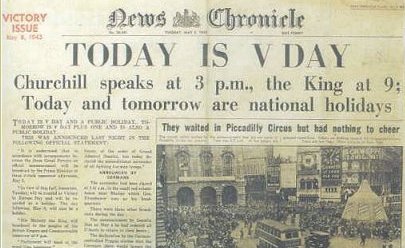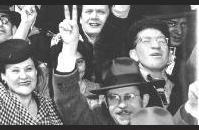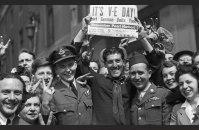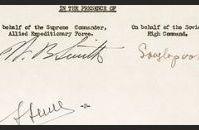V-E DAY AT A GLANCE:

Image Gallery
Remembering V-E DAY: May 8, 1945
The D-Day invasion of Normandy on June 6, 1944, represented the tip of the Allied spear into Germany’s Western Front. Over the next eleven months, millions of tons of supplies, vehicles, and Allied soldiers poured onto the continent to join the fight against the Nazis. The last year of the war in Europe saw some of the hardest fighting in the European Theater of Operations. Operation Market-Garden, the Hurtgen Forest, the Battle of the Bulge, the crossing of the Rhine River into Germany, and the final battles for Berlin and other German cities took enormous tolls in life and property.
The last German V-1 bomb hit a farm in Herfordshire, England, on March 27th, 1945. On April 30th, with the Soviet Army overrunning Berlin, Adolf Hitler committed suicide in his bunker. One week later Germany surrendered. The surrender was announced May 7th, 1945, officially ending the European phase of World War II. Allied leaders decided that May 8th would be celebrated as Victory in Europe Day (V-E Day).
Throughout the day of August 14th, anticipation mounted as people listened to the radio or called their local newspaper for the latest word. The New York Times announced that its revolving news sign in Times Square would remain on continuously during the wait. Many people lingered below the sign, knowing the biggest celebration of all would occur there. The waiting gave cities throughout the country time to announce their plans. Every town and city expected crowds larger than those for V-E Day.
The news of Germany’s defeat set off mass celebrations around the world. Many people gathered to dance in the streets. Overjoyed Russians jammed Red Square in Moscow to celebrate. The London crowds mobbed British Prime Minister Winston Churchill as he was traveling to Parliament to deliver his victory address. In France, Corporal William S. Dryer, U.S. Air Force, wrote to his fiancé, “The people went mad. Mad with laughter and mad with happiness, mad with anything and everything. All up and down the streets the cheering populace let it be known that Hitler was KAPUT…” There was celebrating throughout the United States with the gathering of thousands in New York City’s Times Square after hearing the news.
In Louisiana, Anne Relph recalled being on a train with her Grandmother “and hearing bells ring as we went through little towns…. I didn’t know what was going on until the train stopped, and someone told us that the war in Europe had ended. There was rejoicing, sort of dancing in the street and church bells ringing in every little town we went through. In New Orleans, people were literally dancing in the streets. They were singing, dancing, jumping in and out of fountains…It was like Mardi Gras, and just this incredible sense of relief that part of our war, anyway, was finished…”
Though the war in the Pacific was still being fought and the Japanese surrender would not come for almost another four months, there was no dampening of the spirits of the American people. They celebrated in the streets with the knowledge that with the victory in Europe this long war might actually be coming to an end.
Download a printable version of this At A Glance
TAKE ACTION:


EDUCATION PROJECTS:
Student Travel – WWII Educational Tours
High school and college students, learn the leadership principles that helped win WWII on a trip to France or during a weeklong residential program in New Orleans. College credit is available, and space is limited.
See You Next Year! HS Yearbooks from WWII
Collected from across the United States, the words and pictures of these yearbooks present a new opportunity to experience the many challenges, setbacks and triumphs of the war through the eyes of America’s youth.
The Victory Gardens of WWII
Visit the Classroom Victory Garden Project website to learn about food production during WWII, find lesson plans and activities for elementary students, get tips for starting your own garden and try out simple Victory Garden recipes!
The Science and Technology of WWII
Visit our new interactive website to learn about wartime technical and scientific advances that forever changed our world. Incorporates STEM principles to use in the classroom.
Kids Corner: Fun and Games!
Make your own propaganda posters, test your memory, solve puzzles and more! Learn about World War II and have fun at the same time.






